 |  |
 | |
 |  |
 |  | | ALTERED VISTAS: Hello again, Steve. Can you give us some idea of what it was like in the Marvel offices back in 1979 when the comic began? STEVE MOORE: Okay, here we have our first problem, in that it’s thirty years ago and my memory isn’t what it used to be! I didn’t actually go to the offices much, as they were in Kentish Town, in North London, and I was in Greenwich, in the South-East, so I mostly made contact over the phone and mailed in my scripts by post. Of course then I was using a typewriter (electric, admittedly), so everything was on paper… a top-copy and a carbon copy to the editor, a carbon-copy for my files at home. So I probably didn’t go in to the office more than once a month, unless we were starting out on some new project. And then it would usually just be a quick hello to the other staff, and most of the time spent with the editor. Obviously, Doctor Who Weekly wasn’t the only thing Marvel UK were publishing at the time, so the Doctor Who team were part of a larger organisation. Specifically for Doctor Who, there would have been about four or five people working on the magazine: editor, assistant editor, art and production people, etc. But the staff were constantly changing… I worked under three editors in the relatively short period I was with the magazine: Dez Skinn, who I got on well enough with at the time, Paul Neary, who I also liked, and Alan McKenzie, who I never really took to, possibly because I hadn’t known him in previous years, like I had the other two. I’d already worked with Dez Skinn on House of Hammer, Hulk Weekly, etc., so we already had an established editor/writer relationship… so when Marvel acquired Doctor Who it just seemed natural that I’d get at least some of the writing duties. And I think we had a couple of month’s lead-time, so that gave me a chance to gather some reference material before we started. AV: What was the process for producing a strip, and did it change at all through the years? SM: As I said, I’d worked with Dez Skinn previously, so I was already one of his trusted team of writers and artists. So we’d have a preliminary chat at the beginning of a series or magazine and then I’d come up with the story … in those days we didn’t bother with synopses or outlines... I’d just come up with the first script (sometimes without really knowing where the story was going, if it ran to more than one episode) and send it in. Generally that’d go out pretty much unchanged to the artist, who usually did the whole job: we didn’t often have teams of pencillers and inkers in those days. This was all before computers, of course, so the artist would then deliver the physical artwork, which in turn would go to a freelance letterer who, back then, would actually letter the word-balloons by hand, with a rapidagraph pen, having ruled pencil-lines on gum-backed paper beforehand, and these would be physically stuck to the artwork. These days, I gather, all the lettering’s set using ready-made typefaces, and everything’s put together in the graphics program of the computer. Anyway, after that, the strip would be proof-read and corrections made by the art-person (or ‘bodger’) in the office, and then the physical artwork would be sent off to the printer… whereas these days, again, everything would go to the printer as a PDF computer file. |
|  |  | | AV: We'll start with the back-up strips... How were the back-up strips created? Were you given the monster by the editor then given free reign with the story or was it all left to you? SM: As I said in our earlier interview, we were originally talking about the lead Doctor Who strip being written by me, but after Dez Skinn got Pat Mills and John Wagner to write that, I took the back-up strips, which I was happy enough about, as I wanted rather more to be writing short, complete science fiction stories than doing a character-driven series. As I recall, we discussed the first back-up story and decided that, as Mills & Wagner weren’t using the Daleks in the lead strip, we ought to have |
|
 | them in the first issue. After that, apart from the fact that we’d decided that we ought to run through a variety of the aliens from the series, I think it was pretty much down to me … probably with a phone-call here or there to make sure that if I was doing, say, the Sontarans, that wouldn’t clash with anything anyone else was doing in the magazine. Apart from that, though, I just did pretty much what I liked… from me telling Dez it would be a Sontaran story through to my turning in the script, it’d all be in my hands. I think Marvel had someone serving as consultant to make sure the Doctor Who continuity wasn’t violated, but I don’t remember anything actually coming back to me for alteration. AV: Dez Skinn has said that he felt particularly passionate about the back-up strips. Did this passion communicate itself to you? SM: No, that wasn’t apparent to me at the time. Perhaps he lives in a parallel universe these days. AV: Given that you've said you didn't watch the series before you started on the magazine, how did you research the various monsters? SM: As I said, I think we had a couple of months leeway, and the BBC may well have provided us with some basic reference material… I honestly can’t remember how much of that there might have been. Apart from that, I was just collecting anything I could find in the Radio Times or in other magazines. I know (because I’ve still got it… hmm, come to think of it, if I’ve still got it, I probably wrote some of it!) there was a poster magazine with a feature on the various monsters knocking about at the time… and once the magazine started, there was the feature material there to help as well. So, whatever I could find, basically... |
 |  | | AV: The Return of the Daleks was your first work for the magazine. Any memories? Did a Doctor Who story require different thinking or a different tone to your average comic strip? SM: I found it fairly easy to settle in to. Through the 1970s I wrote about sixty Christmas annuals for Grandreams Ltd., which were mostly adaptations tied to programmes like the Kung Fu or Planet of the Apes TV series, usually with a very minimum amount of reference material,,, I’d often be taken off to a TV company’s private theatre and shown one episode of the series, or just be given the script for the pilot show, and then I’d go off and write the whole book based on that and whatever else I could find. So taking on the Doctor Who universe wasn’t too much different… I was already fairly well practised at looking at characters and situations and thinking “Okay, what are the basics here and how can I construct a story round them?” As for Return of the Daleks… I always found the film industry very easy to satirise, so this isn’t the only story I ever wrote sending up Hollywood. But apart from that, I wasn’t really doing much different to what I’d been doing for the annuals. It was more just a case of settling into the characters and their backgrounds. |
| |
|  |  | | AV: Throwback: The Soul of a Cyberman introduces your first great contribution to the Doctor Who comic strip: Kroton the Cyberman with emotions, who returned in Ship of Fools and later became a regular character in the main DW strip in the 1990s. Was he envisaged as a one-off or always intended to return? Aside from a busy letters page in the magazine, how do you know when a character has 'legs' and a story worth pursuing? SM: I’m pretty sure that when I wrote that first Kroton story, I had no idea of reviving him at all. After all, I was probably writing three or four stories a week at the time, and that doesn’t give you a lot of time to plan ahead! So my attitude used to just be: ‘think of an idea, use it today, think of another one tomorrow.’ The name, incidentally, comes from the ancient Greek colony of Kroton, in southern Italy, where Pythagoras established a school of philosophy! As for the return in “Ship of Fools”, I really can’t remember whether Dez had told me the character was popular or not. I never used to bother to read the letters page anyway, as I guessed it would be fixed to throw a positive light on everything, so I can’t honestly say whether the idea of reviving Kroton was my idea or came from the readers via the office. That second story was one of my favourites, though… but I had no idea that the character continued to appear in later stories, because once I left the magazine I just lost touch with it. |
|
 |  | | AV: Indeed he did. Kroton reappeared in the 1990s (almost nineteen years later) alongside the Eighth Doctor. By this time he was quite a wise-cracking character seemingly quite at odds with your original conception. If you'd known, would you have approved of this development? How would you have developed the character? Did you even see any potential development left in him? SM: I didn’t know at the time, and no, I probably wouldn’t have approved. From what little I’ve seen of this stuff, it looks to be a complete transformation of the original character… he’s now less a ‘Cyberman with a soul’, more just a human being in a funny suit. It’s far too far a move away from the original. If I’d done anything else with him, it would have been to continue with the character pretty much as he was… only a little different from a normal Cyberman, and still very much the “innocent abroad” that he was in Ship of Fools. The later characterisation just seems far too knowing to me. But I don’t know if I ever would have done anything else with Kroton… I never really thought that far ahead at the time. |
 | | |  |
 |  | | AV: It's interesting that you mention the origin of Kroton's name, and did the same in the previous interview for Salander, Mercurius, Harma, Daak and Selene. Is getting the right name for the character important to you? Have any of your characters ever had a name change late in the day to make everything click? SM: Yes, it’s important, but quite often names just come to me. At other times they’re chosen either as part of my own personal mythology, which back then was starting to be largely centred on moon-goddesses… or simply just to show off how knowledgeable I am! But I don’t actually recall changing character’s names at the last minute. I might have done, of course, but I just don’t remember doing so, offhand. AV: And then there's Taiyin, of course, which must again come from your love of Eastern philosophy. And Brimo, the vengeful aspect of a goddess... SM: Here we’re in moon-goddess territory again. As I think I mentioned in our Abslom Daak interview, ‘Taiyin’ is Chinese for ‘The Great Yin’ (as in yin and yang), which is a title of the moon (the sun is ‘Taiyang’). And ‘Brimo’, though used as a title for vengeful aspects of other goddesses, was also an obscure Greek goddess in her own right, who had lunar characteristics. So in these cases it’s both personal mythology, and showing off! |
 |  | | AV: Both Kroton and Daak (not to mention Salander and Mercurius) are quite sad misfit characters, given depth by isolation from their own people and the tragedies that overtake them. Was this way of writing a conscious thing? Something you drew from your own life or your own reading? SM: Well, with Kroton it was an obvious character move: given that the Cybermen were a race without emotions, the natural thing to do was to make a story about one of them who had emotions and didn’t fit. The first Daak story was definitely a reflection of my personal situation, as I was aggrieved and frustrated by a misfiring romantic interlude at the time, and a lot of my feelings came out in the story and character. As for Salander and Mercurius, I hadn’t even thought of them as being misfits until you mentioned it. It may be down to the story-telling process... given a fairly standardised alien race like the Draconians, you have to come up with an individual with special traits for your hero to interact with, and as for the other Star Tigers, like Mercurius, they’re bound to be social outcasts because they’re criminals… the sort of people Daak would associate with. So, no, I don’t think I consciously set out to write about outcasts… it just sort of happened that way. |
| |
|  |  | | AV: What level did you pitch the stories at? K9's Finest Hour, for example, feels like it's aimed at a younger age group than many of the other strips. SM: Frankly, I never used to think about the readership at all, let alone their age! You know, when you’re up against deadlines, all you think is: ‘Come up with a story that works… and before you go to bed this evening.’ Naturally I knew I couldn’t handle adult themes like sex or excess violence, but apart from that all my attention was on the story and just getting it done. Looking back, I doubt that K9 would have been my first choice of character, so it may have been suggested to me by Dez that we should do a story about him. And once you’ve decided to do a solo story about a robot dog, it pretty much asks for a more humorous treatment. That may be what made the story different from the others, rather than any intention to write for a younger audience. |
|
 | |  |  |  |  | |  | | AV: The Stolen TARDIS. The Doctor's appearance in the final frame of this strip carries the vague suggestion that Plutar, the strip's hero, might have been the Doctor in his youth. Was this the idea, or was it simply setting him up for potential further adventures? SM: I think all I was really trying to imply was that Plutar might have gone on to become a Time Lord, rather than being the Doctor in his youth. I may have been setting him up for possible further adventures… but it’s equally as likely I was just rounding up the end of the story. Incidentally, the sequence with the space circus in this story, with its mention of the ancient city of Woldercan and its strange god Yottle, is an in-joke reference to Charles Finney’s The Circus of Doctor Lao, an excellently odd fantasy novel. AV: Did you ever develop any stories or ideas that were vetoed by the editors? SM: Don’t think so. Don’t remember any, anyway. AV: Did you ever have any ideas foisted upon you that you didn't much care for?! SM: Again, I don’t remember this happening. | |  | | | | | 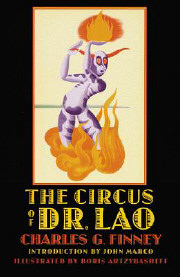 | | | | | 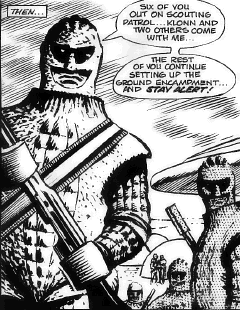 | | | | | | | AV: Deathworld pits Cybermen against Ice Warriors. I bet the Doctor Who Weekly mailbag used to sag with letters asking for strips pitting one monster against another, but the only other time it's happened was in the new TV series in 2006 with Daleks versus Cybermen. Was there ever a temptation to go for these easy, crowd-pleasing stories? SM: Like I said, I didn’t really pay any attention to the letters page… it was pretty juvenile in those early issues, after all. But, as the American comics industry totally failed to realise, crossovers like this only really have any impact if they’re really rare. I don’t think I was particularly tempted to go for this again… after all, I was still working my way through a long list of characters… though if I’d stayed on the back-up stories for longer, it might well have become more of an option. | |
 |  | | AV: Twilight of the Silurians. The editor's footnote suggests this story was written to commemorate the death of Malcolm Hulke, original creator of the Silurians. Is that the case? It also feels a little different in tone to many of the other strips, painting in some of their TV backstory rather than simply using them as monster of the week. SM: No, I’m pretty sure that wasn’t the case. I think it was just that I wrote a Silurian story ‘because their turn had come around’, and that last editorial caption would have been added by Dez. I wasn’t really keeping up with things like deaths of TV series writers. |
| |
 |  | | AV: These backup strips did something that had never been done before in Doctor Who fiction - resurrecting classic monsters that many readers had probably never seen in action or only vaguely remembered. Do you think this was part of their draw? I always remember them more keenly than many of the main strips simply because each week you got something from the Doctor's past. SM: Reading through the stuff again for this interview, I think the main thing that struck me was that those back-up strips are all well-constructed little SF stories that you could read without actually having a great deal of background knowledge about the ‘monsters’ … which I always used to think of as ‘aliens’, and that might be an important distinction. Rather than thinking of each story as some sort of ‘monster fight’… or even as a specifically Doctor Who story… I was thinking ‘what alien race (and background) am I working with?’ and then constructing a solid story within those parameters. I think that’s probably one of the reasons why the stories have lasted so well. And, of course, they do open up a window on the entire universe, suggesting that there’s an infinite amount of time, space and stories continually going on, even if the Doctor himself isn’t present. |
 |  |  |  |  |  |  |  | | 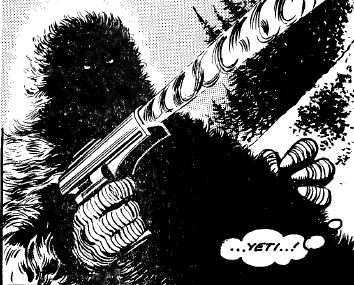 | | | | AV: Yonder the Yeti. Aah, all these years later, and I still remember the footnote about yak butter tea! How much research did you do for strips like this, or did they just feed into interests that you already had? SM: This one just happened to feed into a pre-existing interest in all things oriental and, besides, I had a friend who was a practising Tibetan Buddhist. I suspect I just threw in the reference to buttered tea as a bit of ‘local colour’, and the footnote was actually another editorial intervention. Generally, if I was doing any specific research, it was about the Doctor Who side of things… stuff like buttered tea just came out of my side-interests. | | | | | |  | | | AV: At this point, you switched to the main strip with The Time Witch. Did that feel like a big move? I know you'd originally been promised it when the Weekly began... Was it hard to adjust to suddenly writing for a set hero each week? Did it take time to get a feel for it? Did it present any unique problems in terms of plotting or structuring the stories? SM: I think the main difference was that the stories were mostly longer, but apart from that it was much the same… I was trying to come up with a solid SF story that fitted round the character of the Doctor, rather than one of the alien races. Again, though, each episode tended to be story-driven rather than character-driven: I’d start by thinking about situations and plots for an SF story, and then fit the Doctor into that, rather than start from the Doctor. Whether that’s the best way of doing things, I couldn’t say… but as everyone seems to remember those early stories with affection, maybe it was. I don’t remember any particular problems about the change-over, though. I think I suggested Alan Moore to Dez as a possible replacement for me on the back-up stories, and then apart from that it was down to the usual grind of making sure I got my scripts in every week. Not a lot of time for pondering! | | |
 |  |  |  |  |  |  |  | |  |  | | 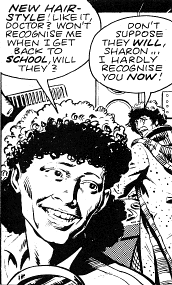 | | | | AV: You inherited the character of Sharon. Was it your decision in your first strip to age her from a slightly goofy child into a fully grown woman? How did you feel about the character? SM: Yes, I inherited her, and I didn’t like her at all! To me, being a young girl rather than a grown-up assistant, that said ‘kids’ story’, and I really wasn’t interested in writing for kids. I just wanted to do well-wrought SF stories, where the invention would appeal to all ages, and besides that, I wasn’t sure I could really get into the head of a young black girl in order to write the character properly. So I just wanted to get rid of her, right from the start… but it’s a bit difficult to ‘safely dispose’ of a child character, as this certainly wasn’t the sort of series where I could have got her killed. So the first part of the process was to have her grow up… then when the readers had got used to that, I could find a legitimate reason to remove her. | | | | | | 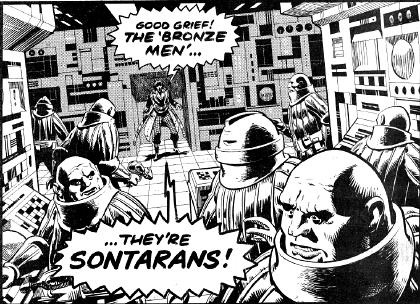 | | | AV: Dragon's Claw has always been one of my favourite Doctor Who Weekly strips. What can you tell us about this? I see it feeds into your interest in all things Eastern... SM: It certainly does… I’d been into the oriental martial arts movie for some years by then… mainly historical sword fighting movies, but I’d be hanging out in Triad-run Chinatown cinema-clubs watching kung fu movies as well. And through the 1970s there was a lot of emphasis on the Shaolin Temple and, more specifically, the legendary “Hall of the Eighteen Bronze Men”, which seem to have been automata that the kung fu practitioner had to fight his way through in order to leave the temple. And, of course, I’d written four annuals based on the Kung Fu TV series. So basically I was just taking a few of my favourite movie riffs and working them into a Doctor Who story… and Dave Gibbons did a pretty good job on the weapons and fighting postures. It was only many years later that I discovered he actually practised Taiji quan, whereas I never got involved in anything that physical! | | | | | | 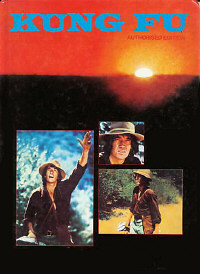 | | | | | AV: Sontarans too - in the main strip for the first time! Was this your influence having worked with them a couple of times on the backup strip? SM: No, I think it was just me thinking: ’Okay, which of the Doctor Who aliens look most like the eighteen Bronze Men?’ AV: You mentioned Dave Gibbons’ interest in martial arts that, unbeknownst to you, fed directly into the presentation of your story. I know some writers tailor what they write to get the best out of the artist they're working with, but I suspect from conversation you don't and like instead just to tell your story and have them groaning in despair, but any thoughts on this? | | | | |
 |  | | SM: I’d always far rather know which artist I’m working with so I can tailor the story to suit their strong points, but this doesn’t happen as often as you might think, especially if you’re writing short stories for a weekly magazine. On Warrior, we set things up as teams from the start, so everyone knew which artist they were working with… and working with Steve Dillon on Laser-Eraser & Pressbutton, where we actually broke the storytelling down together, before I started scripting, was absolutely great. But on the Doctor Who back-up strips I rarely knew who’d be drawing the story when I started scripting it, so I just wrote things as I saw them, and hoped the artist would be able to handle it! AV: The Collector. I always liked the robot in this one - shades of Fritz Lang's Maria/Futura. I note you spell out that the Doctor can only do the travelling back in time due to special circumstances upon their arrival, thus preventing him from solving every future problem in the same way... SM: I was always very fond of the female robot from Fritz Lang's Metropolis, too, so I suspect there's a strong influence there. As for the story itself, it just seemed natural to do a proper "time-travel" story, with the possible paradoxes that turns up, which is not something you often get with Doctor Who... usually, the TARDIS just moves the Doctor to different times and places, where he then has adventures. But I notice that, while Dave Gibbons lettered the rest of the story, that balloon at the foot of page seven, about using the "time stasis fields", is in a different hand. I can't remember for sure after all this time, and without consulting the script, but I suspect that may have been a late intervention, either by Paul Neary or his consultant, Jeremy Bentham, to make sure the plot-device couldn't just be used over and over again. Otherwise, it'd make things too easy for the Doctor to sort out on a regular basis. |
 |  |  | |  | |  | | | AV: Dreamers of Death. By this point Doctor Who Weekly had become Doctor Who Monthly, and the strips became only two parts long. Was this an editorial decision, fearing 'the kids' wouldn't remember from one month to the next? What effect did the change in deadlines have on you? You were now being called to write a lot less material each month. How did the reduction in story length affect the stories you could tell? 'Dreamers' feels like it's been slightly compacted to fit the space. SM: Yes, having gone to monthly, we realised there was no point in doing, say, a six-part serial, because you just wouldn’t carry the readers over half a year with month-long gaps between. So it was a definite decision to cut things back to one or two-part stories. As for its effect on me… well, obviously I wouldn’t have been too happy about my money going down, but that’s a freelancer’s life: some days you’re in work, other days you’re not. But work was quite plentiful in those days, so I probably just filled in with something else. Obviously, given a different format... say | | | | | | two 8-page episodes, rather than four 4-page episodes… you have to structure the stories a bit differently; for a start you only need a cliff-hanger after eight pages, rather than after every four, and so on. And, of course, shorter stories limit the sort of range of material you can do… there’s no point trying to force that epic history of the Roman empire into eight pages, after all… so then you’re looking at doing a much more intimate, self-contained short story. I can’t say, on rereading it, that I found “Dreamers of Death” particularly compacted (but then, of course, I probably wouldn’t)… but I always used to try to cram in as much story as I could anyway. AV: And now you marry Sharon off to the first black guy she meets! What have you got against the girl?! SM: She just wasn’t for me! Having made her an adult, marrying her off was the quickest and simplest way of getting her out of there and still leaving everybody happy. Not that I have any objection to female characters (I’ve written quite a lot of them), but I just didn’t take to Sharon, and I was much more interested in doing stories about ideas, rather than the characters. | |
 | | | 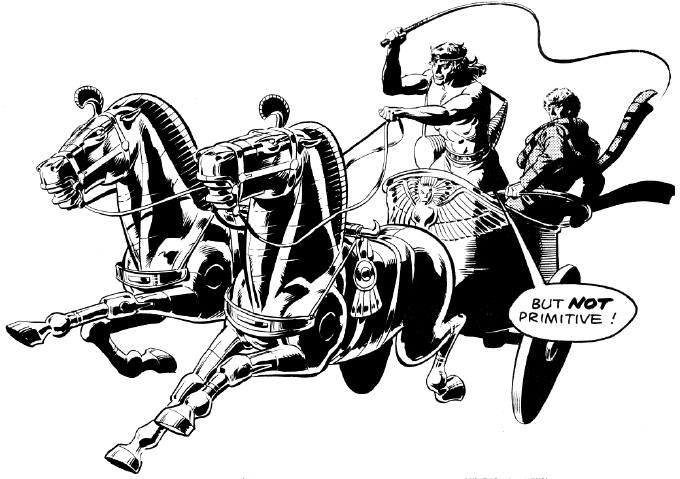 |
 |  | | AV: The Life Bringer. I know from reading other interviews with you, specifically about your new Hercules project, that you've always had a strong interest in Greek myths. I'm guessing the idea for this one came squarely from you. SM: Yes, definitely from me! In fact, really, the ideas pretty well all came from me… Dez Skinn was a pretty hands-off editor, once he’d got an established team. At the time I was reading enormous amounts of Greek myth, as these were the early days of a long-running interest in the Greek moon-goddess Selene… which was why I used the name for a character in Abslom Daak… and I suspect that a large part of the motivation here was to actually get the goddess Selene into the story! Unfortunately, though, despite my having described her in the script as having dark hair, as she’s shown in the ancient iconography, Dave Gibbons obviously decided she’d look better as a blonde! I was a bit miffed! Still, Dave’s a lovely guy, so thirty years on… I’ve almost forgiven him!! AV: The move to just the Doctor and K9 works far better for these shortened strips. Was this your move? SM: I think as much as anything it’s just a product of getting rid of Sharon and not replacing her. Having K9 there does at least give the Doctor someone to exchange the odd word with, and of course he can be quite useful. And as much as anything I think it was a case of me wanting to strip down anything I thought was extraneous, and just get on the with the story. |
|  |  | | AV: War of the Words/Spider God. And now we're down to just one part strips! SM: I don’t think there was any particular ‘policy decision’ about this… we’d just decided to mix things up and do some one-offs and some short serials. As it happens the last two stories I did were one-offs, but I don’t think there’s anything to be read into that. AV: What made you want to leave the magazine? SM: As I said in our Abslom Daak interview, by that time Paul Neary had become group editor, and Alan McKenzie was actually editing Doctor Who Monthly. And one day |
|
 | I went into the office and Paul told me Alan had written half of the next Star Tigers series himself, so I quit. Like I said, Alan denied it, but I preferred to take Paul’s version of events. And that was the end of my involvement. AV: What did you work on immediately after Doctor Who Monthly? SM: Well, I think throughout this period I was still writing Christmas annuals for Grandreams, but the next major project (as far as I remember) was starting to put Warrior together with Dez Skinn, where I mainly did Laser-Eraser & Pressbutton and Father Shandor. |
 |  | |  | | AV: Aside from Daak, which strips are you particularly fond of? SM: Ship of Fools, Dreamers of Death… but as I said earlier, reading through them again now, they all seem to hold up pretty well... AV: What are you working on for the future? SM: Personal circumstances haven’t allowed me to do a great deal of work over the last couple of years, apart from two series of Hercules for Radical Comics… one published last year, the latter coming out as I write (2009). But apart from that I’ve retired from mainstream comics. I’m still working with Alan Moore on The Moon & Serpent Bumper Book of Magic, actually a serious work on western occultism even if it doesn’t sound like it, which Top Shelf will probably publish sometime around 2011. Apart from that, though, I’m mainly going back to non-fiction… a few little items for Fortean Times and hopefully, before too long, picking up work on a long-neglected non-fiction book on the Greek moon-goddess Selene… | | |  | |
| |
|